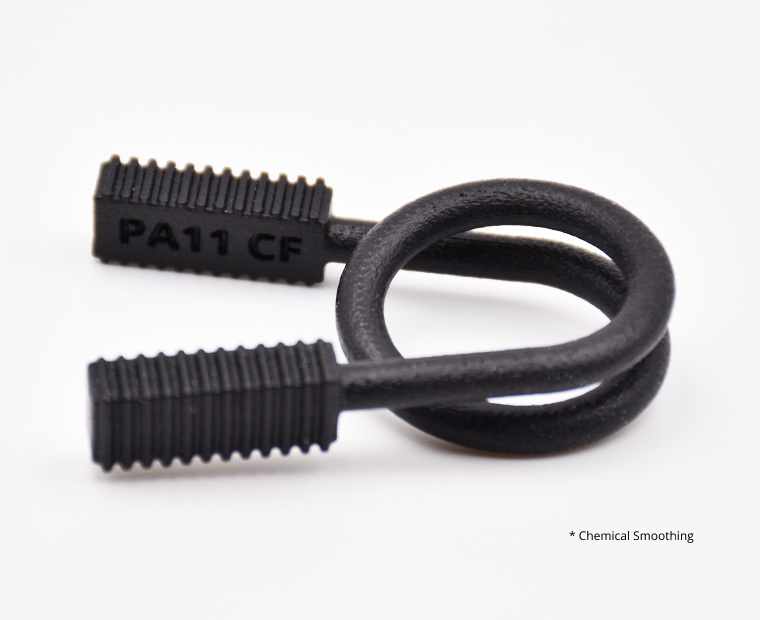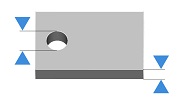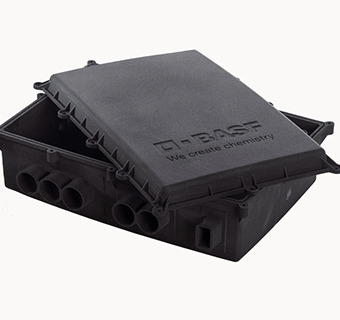Home » 3D Printing Materials » SLS technology » Ultrasint® PA11 CF
Ultrasint® PA11 CF
3D printing material
Ultrasint® PA11 CF (Carbon-filled) is a resistant 3D printing material. Discover the benefits and applications of this bio-derived material.
Ultrasint® PA11 CF Material Guide
What is Ultrasint® PA11 CF?
Ultrasint® PA11 CF is a bio-derived powder material for advanced Powder Bed Fusion applications. This material is one of the strongest materials in the 3D printing industry, combining high ductility and impact performance as well as really high rigidity.
Parts 3D printed with this material are black. This 3D printing material is carbon-fiber-reinforced, providing advanced mechanical performance for your parts when strength and rigidity are needed.
Ultrasint® PA11 CF is printed using Selective Laser Sintering. Please keep in mind that you will have to respect specific design guidelines to avoid any problem during the additive manufacturing process. Be sure to check the material design guidelines while creating your 3D file and before you send it for 3D printing.
What are the possible applications for this material?
Ultrasint® PA11 CF can meet the highest performance requirements. Moreover, thanks to its high rigidity, this material allows 3D printing of lightweights design by reducing wall thicknesses.
High rigidity
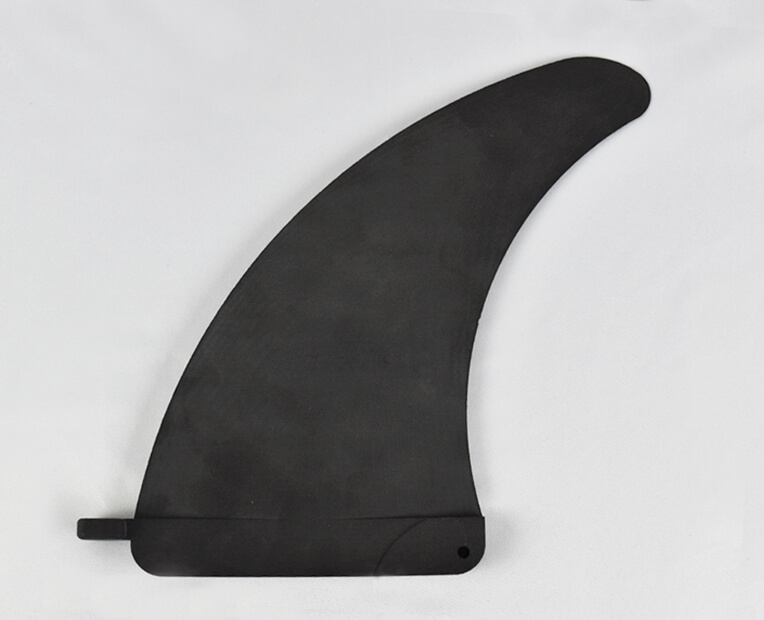
Young’s modulus 4500 MPa
Ultrasint® PA11 is a very rigid material thanks to its carbon-fiber reinforcement, which makes it a perfect option for applications where rigidity really matters
- Excellent impact resistance

Charpy impact unnotched: 63 kJ/m2
Ultrasint® PA11 CF is the perfect choice for lightweight designs without compromising a part’s functionality, which can be interesting to manufacture some motorsport parts.
- High strength-to-weight ratio
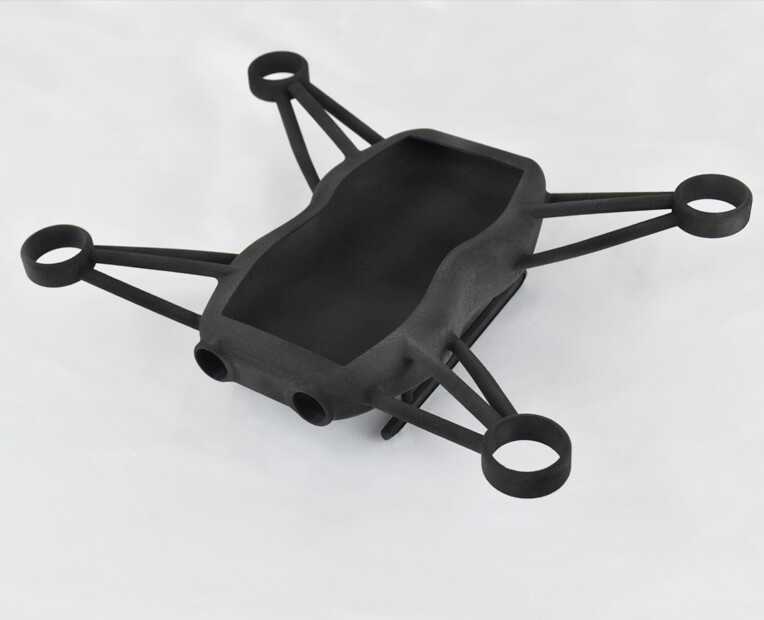
This PA11 material offers an impressive impact resistance, making its use relevant for various demanding industries and applications, and can be a good option for metal parts replacement.
Pricing
The printing price of your design is calculated automatically the moment it is uploaded. As you modify your object (changing material, finishing, size, using our hollowing feature, etc.) you will note that the price changes automatically. The pricing is based on a series of factors, including total volume, object size, and bounding box – to name a few.
The estimated shipping time is also calculated automatically as the object is uploaded and each time you make a modification on it. Delivery time should be added to processing time.
For more information, check our pricing page.
How does Selective Laser Sintering work?
Sculpteo uses a layer by layer process called Selective Laser Sintering (SLS) to manufacture Ultrasint® PA11 CF parts.
The Selective Laser Sintering technology uses a highly specific laser that sinters thin layers of powder together one layer at a time. After each round of lasering, the printing bed is lowered and another layer of powder is evenly swept across the top for another round of sintering. This 3D printing process continues until the part is fully printed according to the 3D file.
| Maximum size raw | 320x280x330 mm |

| The maximum size of your models are limited by the physical size of our 3D printers – nothing can be printed larger than the printer bed. |
Due to the printing process, your objects will have upskin and downskin. Upskin is a little concave, whereas downskin will show slight convex. Upskin will appear on the top of your object, downskin at the bottom. This is important to consider when you set the orientation of your 3D model. If the upskin and downskin will affect your design, set the orientation beforehand and we will honor it, if you are not sure, our technicians will choose the best one. |
| Standard layer thickness | 100µm |
| Accuracy | ± 0.3% (minimum of ± 0.3 mm) |

| Minimum wall thickness | 1mm |

| Stemmed elements with support | 1.5mm |
| Stemmed elements without support | 1.5mm |

Minimum height and width details | Embossed : 0.5 mm
|
| Ratio Depth / width | 1/1
|
| Enclosed parts ? | Yes |
| Interlocking parts ? | Yes |

Our material has the ability to print the most complex designs of our materials . An example of a complex design is a volume enclosed within another volume, like a chain or a ball joint connection. Our printers have the ability to print a fully interlocked chain, with no support structures to remove. |
| Minimum spacing between fixed walls | 0.5 mm |
| Minimum clearance between parts | 0.5 mm |

For a successful 3D print a minimum clearance between objects is required to allow excess material to be sand blown out. If this space is not left within the design, the object will be a solid. This is particularly important for articulated objects – as the space left between the walls will define the object’s ability to move.
Clearance should be at least 0.5 mm, however that is the minimum for small objects. Larger objects require more space between their parts. Our printer beds are heated during the process, and larger objects are heated for longer periods. A small space between large objects runs the risk of melting together as it remains under heat for a long period of time. In some other cases, holes should be added to allow us to drain for the excess powder material within the clearance.
| Hollowing ? | Yes: 5mm |
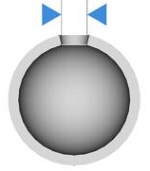
Our online hollowing optimization tool has the ability to greatly reduce the price and the weight of a print by reducing the amount of material used. Using the tool requires adding two holes to your model, which will serve as the drain for the excess powder material within the object. The minimum size of these holes is determined by our website. Otherwise, it is possible to hollow your object manually in your 3D modeling software. |
Value (Dry) | Value (Cond) | Method | |
Tensile Strength | 82 MPa (X) / 55 MPa (Z) | 71 MPa (X) / 48 MPa (Z) | ISO 527-2 |
Tensile Modulus | 5900 MPa (X) / 2500 MPa (Z) | 4550MPa (X) / 2000 MPa (Z) | ISO 527-2 |
Elongation at Break | 7% (X) / 11% (Z) | 11% (X) / 17% (Z) | ISO 527-2 |
Charpy Impact unnotched | 54 kJ/m² (X) / 33 kJ/m² (Z) | 63 kJ/m² (X) / 51kJ/m² (Z) | ISO 179-1 |
HDT B (0.45 MPa, dry) | 189°C | 189°C | ISO 75-2 |
* The test conducted by Sculpteo has shown different values for the elongation at break and tensile strength. Please contact us for further details
Related content:
- 3D printing and automotive
- Drone manufacturing and additive manufacturing
- What are the best robust 3D printing materials?
- 3D printing in the medical sector: Why is it a revolution?
- Advanced materials and mechanical 3D printing
- What are the advantages of carbon-filled plastic for additive manufacturing?
- How to 3D print bioplastics?
Ready to 3D print with Ultrasint® PA11 CF
With Sculpteo’s online 3D printing service you’re just a few clicks away from professional Ultrasint® PA11 CF 3D printing. Your 3D model is printed with the highest quality and delivered straight to your door.
Get started now!


 Connect with Google
Connect with Google Connect with Facebook
Connect with Facebook